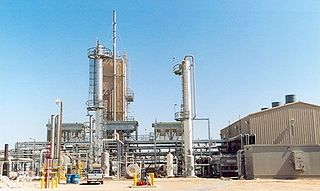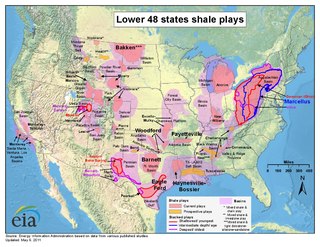Related Research Articles

Helium is a chemical element with the symbol He and atomic number 2. It is a colorless, odorless, tasteless, non-toxic, inert, monatomic gas and the first in the noble gas group in the periodic table. Its boiling and melting point are the lowest among all the elements. It is the second lightest and second most abundant element in the observable universe. It is present at about 24% of the total elemental mass, which is more than 12 times the mass of all the heavier elements combined. Its abundance is similar to this in both the Sun and in Jupiter, due to the very high nuclear binding energy of helium-4, with respect to the next three elements after helium. This helium-4 binding energy also accounts for why it is a product of both nuclear fusion and radioactive decay. Most helium in the universe is helium-4, the vast majority of which was formed during the Big Bang. Large amounts of new helium are created by nuclear fusion of hydrogen in stars.
Helium-3 is a light, stable isotope of helium with two protons and one neutron. Other than protium, helium-3 is the only stable isotope of any element with more protons than neutrons. Helium-3 was discovered in 1939.

Natural gas is a naturally occurring mixture of gaseous hydrocarbons consisting primarily of methane in addition to various smaller amounts of other higher alkanes. Usually low levels of trace gases like carbon dioxide, nitrogen, hydrogen sulfide, and helium are also present. Natural gas is colorless and odorless, so odorizers such as mercaptan, which smells like sulfur or rotten eggs, are commonly added to natural gas supplies for safety so that leaks can be readily detected.
An energy crisis or energy shortage is any significant bottleneck in the supply of energy resources to an economy. In literature, it often refers to one of the energy sources used at a certain time and place, in particular, those that supply national electricity grids or those used as fuel in industrial development and population growth have led to a surge in the global demand for energy in recent years. In the 2000s, this new demand – together with Middle East tension, the falling value of the US dollar, dwindling oil reserves, concerns over peak oil, and oil price speculation – triggered the 2000s energy crisis, which saw the price of oil reach an all-time high of $147.30 per barrel ($926/m3) in 2008.

Natural gas prices, as with other commodity prices, are mainly driven by supply and demand fundamentals. However, natural gas prices may also be linked to the price of crude oil and petroleum products, especially in continental Europe. Natural gas prices in the US had historically followed oil prices, but in the recent years, it has decoupled from oil and is now trending somewhat with coal prices.

The National Helium Reserve, also known as the Federal Helium Reserve, is a strategic reserve of the United States holding over 1 billion cubic meters (109 m3) of helium gas. The helium is stored at the Cliffside Storage Facility about 12 miles (19 km) northwest of Amarillo, Texas, in a natural geologic gas storage formation, the Bush Dome reservoir. The reserve was established with the enactment of the Helium Act of 1925. The strategic supply provisioned the noble gas for airships, and in the 1950s became an important source of coolant during the Cold War and Space Race.

The Western Canadian Sedimentary Basin (WCSB) underlies 1.4 million square kilometres (540,000 sq mi) of Western Canada including southwestern Manitoba, southern Saskatchewan, Alberta, northeastern British Columbia and the southwest corner of the Northwest Territories. This vast sedimentary basin consists of a massive wedge of sedimentary rock extending from the Rocky Mountains in the west to the Canadian Shield in the east. This wedge is about 6 kilometres (3.7 mi) thick under the Rocky Mountains, but thins to zero at its eastern margins. The WCSB contains one of the world's largest reserves of petroleum and natural gas and supplies much of the North American market, producing more than 450 million cubic metres per day of gas in 2000. It also has huge reserves of coal. Of the provinces and territories within the WCSB, Alberta has most of the oil and gas reserves and almost all of the oil sands.

The Anadarko Basin is a geologic depositional and structural basin centered in the western part of the state of Oklahoma and the Texas Panhandle, and extending into southwestern Kansas and southeastern Colorado. The basin covers an area of 50,000 square miles (130,000 km2). By the end of the 20th Century, the Anadarko Basin was producing the largest amount of natural gas in the United States. Notable oil and gas fields within the basin include the Hugoton-Panhandle Gas Field, West Edmond Field, Union City Field and the Elk City Field. The basin is also the only commercial source of iodine in the United States and a major producer of helium.
Natural gas is a commodity that can be stored for an indefinite period of time in natural gas storage facilities for later consumption.
Peak gas is the year in which the maximum global natural gas production rate will be reached, after which the rate of production will enter its terminal decline. Although demand is peaking in the United States and Europe, it continues to rise globally due to consumers in Asia, especially China. Natural gas is a fossil fuel formed from plant matter over the course of millions of years. Natural gas derived from fossil fuels is a non-renewable energy source; however, methane can be renewable in other forms such as biogas. Peak coal was in 2013, and peak oil is forecast to occur before peak gas. One forecast is for natural gas demand to peak in 2035.
Hydrocarbons are the leading sector in Algeria's mineral industry, which includes diverse but modest production of metals and industrial minerals. In 2006, helium production in Algeria accounted for about 13% of total world output. Hydrocarbons produced in Algeria accounted for about 2.9% of total world natural gas output and about 2.2% of total world crude oil output in 2006. Algeria held about 21% of total world identified resources of helium, 2.5% of total world natural gas reserves, and about 1% of total world crude oil reserves.

Petroleum has been a major industry in the United States since shortly after the oil discovery in the Oil Creek area of Titusville, Pennsylvania in 1859. The industry includes exploration, production, processing (refining), transportation, and marketing of natural gas and petroleum products. In 2018, the U.S. became the worlds largest crude oil producer, producing 15% of global crude oil, surpassing Russia and Saudi Arabia. The leading oil-producing area in the United States in 2019 was Texas, followed by the offshore federal zone of the Gulf of Mexico, North Dakota and New Mexico. In 2020, the top five U.S. oil producing states were Texas (43%), North Dakota (10.4%), New Mexico (9.2%), Oklahoma (4.1%), and Colorado (4.0%).

Shale gas in the United States is an available source of natural gas. Led by new applications of hydraulic fracturing technology and horizontal drilling, development of new sources of shale gas has offset declines in production from conventional gas reservoirs, and has led to major increases in reserves of U.S. natural gas. Largely due to shale gas discoveries, estimated reserves of natural gas in the United States in 2008 were 35% higher than in 2006.
Bangladesh suffers with heavy energy crisis with the gradual expansion of economic activities of the country. The estimations and reserves of energy resources show future potentials but a small fraction of them are being utilized which proved to be insufficient. Moreover, the impact of climate change and environment pollution has also been significantly felt. As a result, the successive governments have aimed at formulating an effective energy policy which would address these concerns. The energy policies have also received extensive criticisms especially on the questions of energy export and methods of extraction.

Helium production in the United States totaled 73 million cubic meters in 2014. The US was the world's largest helium producer, providing 40 percent of world supply. In addition, the US federal government sold 30 million cubic meters from storage. Other major helium producers were Algeria and Qatar.

Natural gas was the United States' largest source of energy production in 2016, representing 33 percent of all energy produced in the country. Natural gas has been the largest source of electrical generation in the United States since July 2015.

Helium Act of 1925, 50 USC § 161, is a United States statute drafted for the purpose of conservation, exploration, and procurement of helium gas. The Act of Congress authorized the condemnation, lease, or purchase of acquired lands bearing the potential of producing helium gas. It banned the export of helium, for which the US was the only important source, thus forcing foreign airships to use hydrogen lift gas. The Act empowered the United States Department of the Interior and United States Bureau of Mines with the jurisdiction for the experimentation, production, repurification, and research of the lighter than air gas. The Title 50 codified law provided the authority for the creation of the National Helium Reserve.

Petrolia Oil Field is a North Texas segment of land located in Clay County, Texas and the Great Plains. The hydrocarbon exploration site was geographically within 10 miles (16 km) of the Red River of the South. The oil and gas reservoir was located between Texas State Highway 79 and Texas State Highway 148 converging at Petrolia, Texas.

Cliffside Gas Field is located in the Texas Panhandle bearing 9 miles (14 km) west of Texas Highway 87 and 15 miles (24 km) northwest of Amarillo, Texas. The Great Plains Panhandle area is located in Potter County, Texas within the vicinity of the unincorporated community Cliffside, Texas.
References
- 1 2 3 4 5 6 7 8 9 10 Ben-Chieh, Liu (1982). "Helium conservation and supply and demand projections in the USA". Energy Economics.
- 1 2 3 4 5 6 7 Uri, Noel D. (1987). "Helium conservation: Supply and demand projections in the USA reconsidered". Energy Economics. doi:10.1016/0140-9883(87)90011-9.
- 1 2 3 4 5 6 7 8 9 10 11 12 13 14 15 16 17 Epple, Dennis (1982). "The Helium Storage Controversy: Modeling Natural Resource Supply: The complex issue of helium storage provides a case study of the difficult decisions involved in using natural resources". American Scientist.
- 1 2 3 4 5 6 7 8 9 10 11 12 13 14 15 16 17 18 19 20 21 22 23 24 25 26 American Physical Society, American Chemical Society, Materials Research Society (2016). “Responding to the U.S. Research Community’s Liquid Helium Crisis”. https://www.aps.org/policy/reports/popa-reports/upload/HeliumReport.pdf
- ↑ Lvovsky, Y., Stautner, E. W., Zhang, T. (2013). “Novel technologies and configurations of superconducting magnets for MRI”. Supercond. Sci. Technol. 26 093001
- 1 2 American Physical Society (1995). “National Policy”. https://www.aps.org/policy/statements/95_3.cfm
- 1 2 3 4 Zhang, S. (2013). “United States extends life of helium reserve”. Nature News.
- 1 2 3 4 5 6 7 8 9 10 11 12 13 14 Wheeler M., Sears (2015). Helium The Disappearing Element. Springer. ISBN 978-3-319-15123-6.
- ↑ Nuttall, W. J., Clarke, R., Glowacki, B., (2012). “The Future of Helium as a Natural Resource”, Routledge.